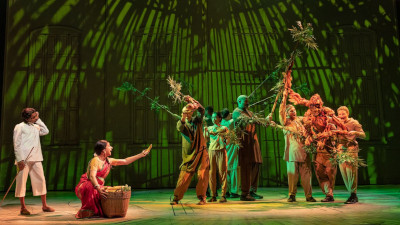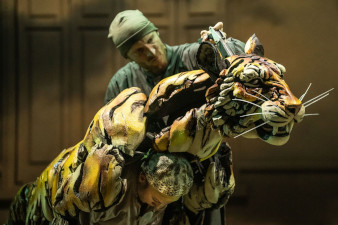
Paulanne Simmons
"Life of Pi"
Turning a much beloved novel into a play is always difficult. But it becomes a real challenge when that novel is a fable of mythic proportions, a fable that contains live animals on a tiny raft, and a man-eating island. What’s more, the novel has already been made into a critically acclaimed film. With all that in mind, we cannot help but give director Max Webster and his stalwart cast and crew enormous credit for staging "Life of Pi". That they do it so well is a testament to their talent. And we can only be grateful the show has transferred this season to Broadway’s Gerald Schoenfeld Theatre after winning five 2022 Olivier Awards across the pond. Adapted by Lolita Chakrabarti from Yann Martel’s best-selling novel, "Life of Pi" tells the story of 17-year-old Pi Patel, the sole survivor of a shipwreck that he claims left him stranded on a raft with a hyena, a zebra, an orangutan and a Royal Bengal tiger. Pi is played by Hiran Abeysekera. The animals are manipulated by a team of talented puppeteers. The animals are so huge and so lifelike they could easily overwhelm a lesser actor than Abeysekera.
Pi, whose full name is Piscine Molitor Patel (he was named after a pool in Paris), and his entire family were on board a Japanese cargo ship headed for Canada, because his father (Rajesh Bose) decided they were no longer safe in their hometown of Pondicherry, India. The animals were onboard because Pi’s father was a zookeeper, and he was moving all the animals, along with his family, to their new home. The play opens after Pi has washed up on the shores of a Mexican village. He is in a hospital, where Mr. Okamoto (Daisuke Tsuji), a representative from the Japanese Ministry of Transport, and Lulu Chen (Kirstin Louie, Celia Mei Rubin the night I saw the show) from the Canadian Embassy are trying to get Pi to tell them exactly what happened. Pi’s version of the story includes the death of the Zebra and the orangutan in the jaws of the hyena and his uneasy truce with the tiger, after the tiger kills the hyena. With the help of various apparitions, including his father, Pi learns how to survive by conserving his food and catching and eating a passing turtle, after he has overcome his vegetarian qualms. Eventually Pi spots an island he thinks will provide deliverance, only to discover the island eats all creatures who dare trespass. Unfortunately, we never see the island, but Tim Lutkn’s lighting and Andrzej Goulding’s video do much to create the otherworldly atmosphere that Pi’s story elicits. Needless to say, Okamoto and Chen are not convinced by Pi’s story. So he gives them another, one more believable, but less satisfying. Because by now we know Pi is searching for a deeper and truer reality, where meaning is more powerful than mere facts. Early in the play, we learn that Pi has been attending a Christian church, a Muslim mosque and a Hindu temple. He doesn’t see much difference in the three religions. All religions search for meaning beyond our day-to-day existence. And all religions try to locate our position and responsibilities in a universe we don’t completely understand. Thus the lesson Pi offers, which exists in the realm of scriptural wisdom, would sit comfortably in any one of them. |
| recordings | coupons | publications | classified |


